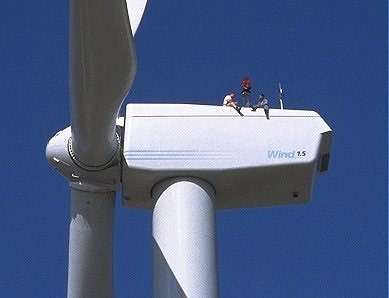BIRDSEDGE, HUDDERSFIELD, WEST YORKSHIRE
Government coverup about noise levels - From the Times Online website
Isn't Green Energy a good idea if we're going to save the world from Climate Change?
Links to articles, web sites and downloads about wind turbines and energy policy
BOLT
BIRDSEDGE AND DISTRICT OPPOSITION TO
LARGE TURBINES
Just why are these wind turbines a Bad Thing?
Here are some area specific and technical reasons why we don't want our village swamped by tubines that are almost the height of Blackpool Tower.
 Visual impact on an area of outstanding natural beauty
Visual impact on an area of outstanding natural beauty- Looming visual and audible presence over the villages of Birdsedge, High Flatts, and houses and farmsteads in Cumberworth, including Five Lane Ends area
- Cumulative effect of this wind farm combined with others already built and at the planning stage in the surrounding area – mostly over the border in South Yorkshire, but very close to Birdsedge and High Flatts. The Kirklees development plans also allow for fourteen turbines and they are looking in our direction. As you drive along the A629 from the Penistone Roundabout you can already see 26 turbines without turning your head. Enough is enough!
- Proximity to a residential community.
- Proximity to rural roads popularly used by horse riders, cyclists, walkers, dog-walkers, runners and hikers as well as local traffic and agricultural traffic. Three turbines on the new plan are within topple distance of well used roads. One is within topple distance of two roads.
- Proximity to an area on Birdsedge Lane designated by Kirklees as a nature reserve and with planning permission for stables for Riding for the Disabled.
- Potential dangers caused by ice being dropped or flung from the blades in winter (heavy chunks as large as 2 feet across having been reported in Lincolnshire). Three are close enough to roads that ice-drop is a serious hazard. Even a small piece of ice can kill when flung from a blade or dropped from a height. From a very large wind turbine the 'throw' would certainly be within a 200 metre radius and could be up to 700 metres. (And we are in the same area in which accumulated ice brought down Emley Moor mast in March 1969, so don't think: It will never happen here.)
- Potential dangers from debris, (turbine parts) due to mechanical failure, as has been experienced in Scottish, American and European wind farms and even (twice) in a turbine in Sheffield and in several turbines in this area during the high winds in early 2012
- Potential Sun /Light flicker/strobe effect caused by such large blades at times of low sun causing major annoyance for residents in the shadow (most of the village) and also a driving hazard at times of low sun (much of the day in the winter time). Very few huses will escape this annoyance and many will be within the flicker range of two, three or even all four turbines. Flicker not only causes annoyance which can affect wellbeing, promote feelings of irritability and anger (leading to aggression), but can also cause migraines and other health hazards. For some people, flashing lights can trigger potentially lethal epileptic seizures.
- Potential noise disturbance to the school and dwellings across the whole frequency spectrum (the swish swish swish of blades for instance).
- Very low frequency noise (that low rumbling noise you can barely hear but you feel it in your body) in particular is associated with health hazards such as anxiety and depression; aggravation and aggression; insomnia and/or loss of quality in sleep; lessened concentration and a general malaise. This affects not only humans but wild and domestic animals and birds. No amount of double glazing will keep it out of your house, it travels through wall unimpeded.
- Potential harm to domestic animals, horses, cattle and sheep on the surrounding grazing land – and on your pets whose hearing is more sensitive than yours.
- Potential damage to birds
- Potential damage to bats. Bats are not killed by the blades of a turbine, but the spinning blades cause a pressure differential that is great enough to kill bats. Their lungs are very soft and the edffect is the same as a diver getting a fatal case of 'the bends'. The blood vessels inside the lungs burst and the bat effectively drowns in its own blood. We have every kind of Britsh bat in this area and all are protected by law.
- Damage to a potential Iron Age archaeological site (never dug) on the crown of Castle Hill.
- Potential for a mid-air accident as there is a local airstrip within 1 km of turbines (which will be in the flight path of the only runway)
- Wind turbines may cause interference with television signals requiring adjustment or replacement of aerials or installation of cable/ satellite.
- Massive disruption to local roads for many months during construction including the enlargement of junctions in order for the extra large vehicles to turn to reach the site.
- Massive industrial construction in a greenbelt area
- There is currently a private members bill going through parliament Wind Turbines (Minimum Distances from Residential Premises) Bill [HL] 2010-11, which will set the minimum distance from housing at 1.5 miles (approx 2 kilometres. This plan sets turbines at less than a quarter of that distance from housing.